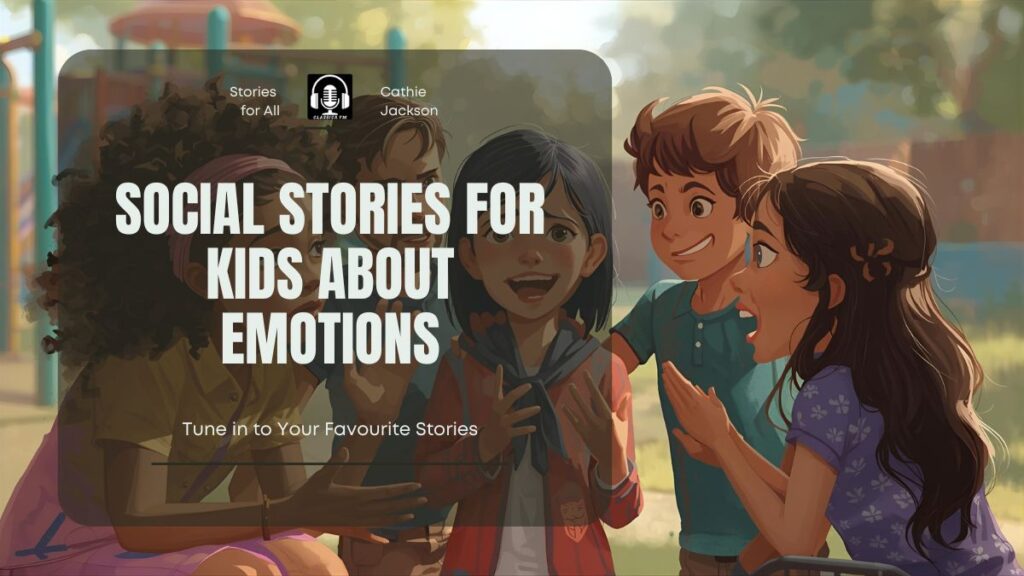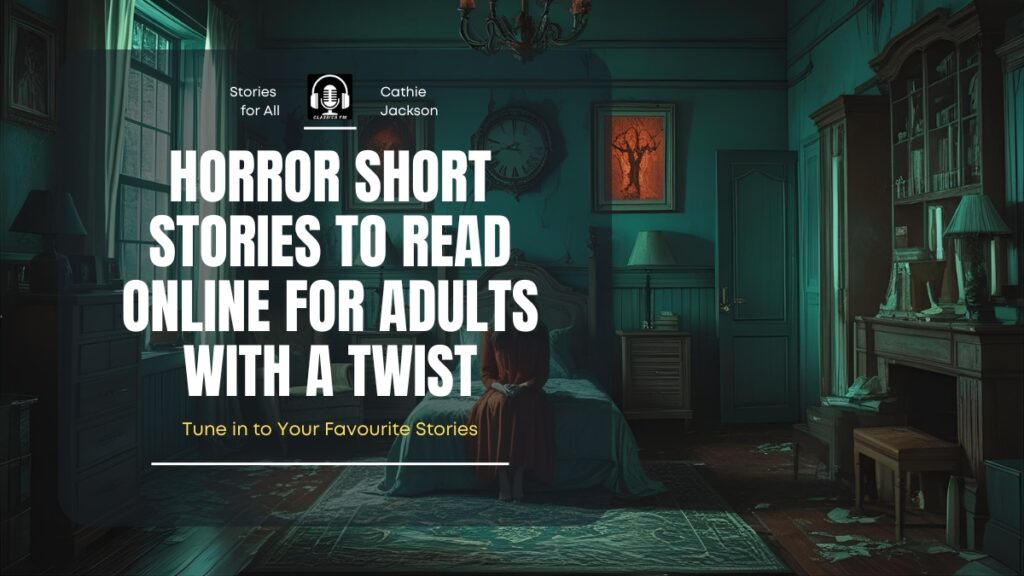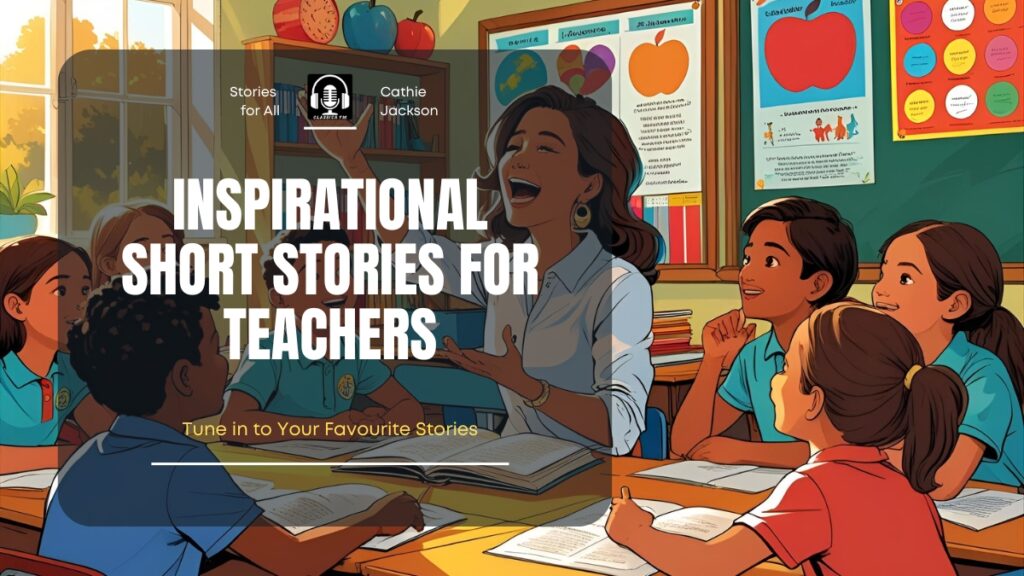Have you ever watched a child have a meltdown over the “wrong” color cup? To us, it feels tiny. To them, it is a full-blown storm. Their face turns red, their fists clench, and tears spill like rain.
Childhood emotions are like the weather. One moment it is sunny, the next it is thunder and lightning. Unlike adults, kids do not yet know how to carry an umbrella.
That is where social stories for kids about emotions come in. They act like emotional umbrellas, simple little narratives that help children face the storm without getting drenched.
Social Stories for Kids About Emotions
From giggles to tears, emotions are part of every day. Social stories help kids make sense of them all.
1. The Balloon That Wouldn’t Pop
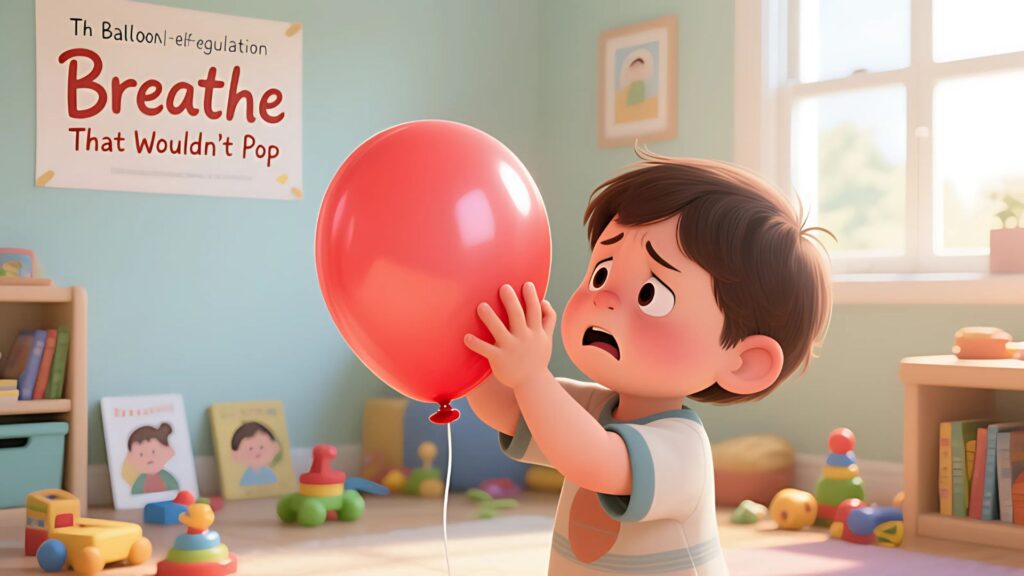
Leo was six years old.
He loved drawing dragons, building block towers, and pretending his bed was a pirate ship.
But there was one thing Leo didn’t love.
He didn’t love the way he felt when he got angry.
The Balloon Feeling
When Leo got mad, it was like his tummy filled with balloons.
Not just one balloon.
Not just two.
Dozens of balloons, all blowing up at once.
The bigger they got, the tighter his chest felt.
His face turned red.
His fists clenched.
He wanted to shout.
He wanted to stomp.
Sometimes, he wanted to explode.
The Spilled Juice
One Tuesday morning, Leo sat at the kitchen table.
His mom poured him a cup of orange juice.
Leo reached for it, but his elbow bumped the cup.
Crash!
Juice spilled across the table and dripped onto the floor.
“Leo!” his little sister Emma cried. “You spilled it!”
The balloon feeling rushed in.
One balloon.
Two balloons.
Three.
His cheeks burned hot.
He wanted to yell, It’s not my fault!
But the words stuck in his throat.
His mom knelt with a towel.
“It’s okay, Leo,” she said. “Accidents happen. Let’s clean it up.”
But Leo could feel balloon number four and five blowing up inside him.
He wanted the balloon to pop.
Coloring Time
Later at school, Leo worked on a drawing.
He was coloring a rocket ship.
He picked his favorite red crayon for the flames.
He pressed hard, filling in every line.
Just then, his classmate Max leaned over.
“That doesn’t look like a rocket,” Max laughed.
“It looks like a chicken!”
Some kids giggled.
The balloons rushed back.
One. Two. Three. Four. Five.
Leo’s fists squeezed his crayon.
He wanted to snap it in half.
He wanted to shout.
But before he could, his teacher, Mrs. Flores, walked by.
She noticed his clenched fists.
“Leo,” she said softly. “Why don’t you take a deep breath?”
“I can’t,” Leo muttered. “I feel like I’m going to pop.”
The Teacher’s Trick
Mrs. Flores sat in a chair beside him.
“Anger can feel like a balloon inside us,” she explained.
“The more we feed it, the bigger it gets.”
Leo blinked.
That’s exactly how I feel, he thought.
“But here’s the secret,” Mrs. Flores whispered.
“You don’t have to let the balloon pop. Each deep breath is like letting a little air out.”
She puffed up her cheeks.
Then she blew out slowly, like a balloon deflating.
“Pfffffff.”
Leo stared.
“Want to try?” she asked.
Leo hesitated.
The balloon inside him felt so full.
But he nodded.
He closed his eyes.
He took a big breath in through his nose.
Then he blew it out slowly through his mouth.
Pfffffff.
He imagined one balloon shrinking.
The pressure eased.
“Try again,” Mrs. Flores said.
Leo breathed in.
Then out.
Another balloon shrank.
By the third breath, his fists relaxed.
His cheeks cooled.
His rocket picture didn’t look so bad anymore.
Practice at Home
That afternoon, Leo told his mom about the balloon trick.
“Mrs. Flores said each breath lets air out,” Leo explained.
His mom smiled.
“That’s a smart teacher you have. Want to practice together?”
They sat cross-legged on the rug.
His mom held up her hands like she was blowing up a balloon.
She puffed her cheeks.
Then she let the air out with a squeaky sound.
“Pfffffttttt!”
Leo burst out laughing.
The balloon in his tummy didn’t stand a chance against that sound.
The Block Tower
The next day, Leo was building a block tower with Emma.
He stacked the blocks carefully.
One on top of another.
The tower grew taller and taller.
Then Emma zoomed her toy car across the floor.
Crash!
The tower toppled over.
Blocks scattered everywhere.
Emma giggled. “Oops!”
The balloon feeling exploded inside Leo.
His fists clenched.
His face turned red.
One balloon.
Two balloons.
Three.
But then he remembered.
Breathe, Leo. Let the air out.
He closed his eyes.
One breath.
Two breaths.
Three.
The balloons shrank.
He opened his eyes.
Instead of yelling, he picked up a block.
“Let’s build it again,” he said. “But no cars this time, okay?”
Emma nodded. “Okay!”
Balloons at the Park
On Saturday, Leo went to the park with his dad.
He climbed to the top of the jungle gym.
He was about to go down the slide when a bigger kid cut in front of him.
“Hey! I was next!” Leo shouted.
The balloon feeling swelled.
Fast.
Big.
Tight.
But then he saw his dad on the bench.
His dad gave him a thumbs-up.
Leo remembered.
Breathe, Leo.
One breath.
Two breaths.
Three.
The balloons deflated.
By the time it was his turn again, he wasn’t mad.
He slid down with a smile.
Helping a Friend
One day, Max lost a game at recess.
He stomped his feet.
His face turned red.
Leo saw it.
Max had balloons too.
Leo walked over.
“Try breathing,” he whispered.
“Pretend you’re letting air out of a balloon.”
Max frowned.
But he tried.
He puffed his cheeks.
He blew out.
His shoulders relaxed.
“Huh,” Max said. “That kinda works.”
Emma’s Broken Crayon
Later, Emma cried when her crayon broke.
She threw the pieces on the floor.
Leo knelt beside her.
“Do the balloon breath,” he told her.
He puffed up his cheeks.
He blew out slowly.
Emma giggled at his silly face.
Her tears dried.
She forgot about the broken crayon.
The Secret Power
Leo realized something.
Everyone had balloons.
Everyone had anger that grew and grew.
But not everyone knew the trick.
Leo knew.
He could keep his balloon from popping.
And he could help other kids too.
That made him feel proud.
That made him feel strong.
That made him feel calm.
What Leo Learned
Anger is like a balloon.
The more we hold it in, the bigger it gets.
But each deep breath lets air out.
Breathing makes anger smaller.
Breathing makes us calmer.
Breathing keeps the balloon from popping.
2. Maya’s Rainbow Rain
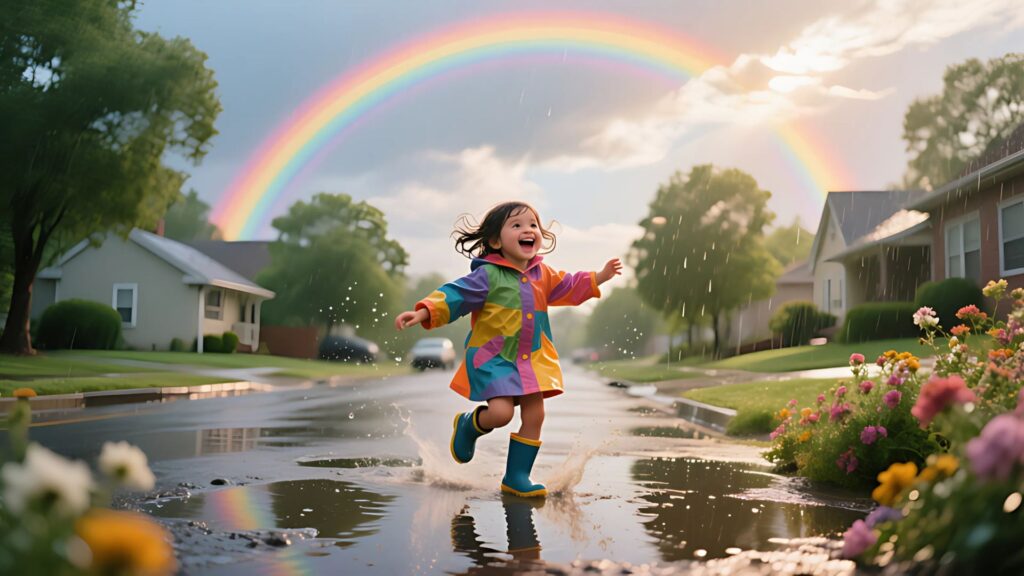
Maya woke up to the sound of rain.
The drops tapped against her window like tiny drummers.
She pulled her blanket over her head.
Her chest felt heavy, like a wet coat she couldn’t take off.
She whispered, “Why do I feel so sad?”
But no one answered.
Only the rain.
At breakfast, her mom poured milk into a bowl.
The milk swirled, white and cloudy, just like Maya’s feelings.
“Good morning, sweet pea,” her mom said.
Maya mumbled back.
Her spoon clinked against the bowl.
The cereal grew soggy.
She didn’t take a bite.
At school, Maya kept her head down.
The teacher smiled, but Maya couldn’t smile back.
Her friends laughed at a joke.
Maya didn’t join in.
It felt like a wall stood between her and everyone else.
A wall built out of rain.
During art class, she picked up a blue crayon.
Blue for raindrops.
She drew lines falling across the page.
One, two, three, a hundred.
The paper filled with streaks.
Her teacher came by.
“That’s a lot of rain, Maya,” she said gently.
Maya nodded.
“It never stops,” she whispered.
When she got home, the sky outside was still gray.
She kicked off her shoes and curled up on the couch.
Her mom sat down beside her.
“What’s going on, my love?” she asked.
Maya shrugged.
Her throat felt tight.
She wanted to speak but couldn’t.
Her mom waited.
She didn’t rush her.
Finally, Maya said, “It’s like rain in my heart.”
Her mom pulled her close.
“A rainy heart,” she repeated softly.
Maya buried her face in her mom’s sweater.
The sweater smelled like soap and warm tea.
Tears slid down her cheeks.
Her mom didn’t wipe them away.
She just held her.
And the rain poured out.
After a while, Maya sniffled.
Her mom pointed toward the window.
“Look,” she whispered.
Outside, the rain was still falling.
But something had changed.
A rainbow stretched across the sky.
Colors curved over the rooftops.
Red, orange, yellow, green, blue, indigo, violet.
Bright against the gray.
Maya gasped.
“It’s beautiful.”
Her mom smiled.
“Rain makes rainbows possible,” she said.
Maya blinked.
“So… even sad days can make something pretty?”
Her mom nodded.
“Exactly. The rain won’t last forever. And sometimes, it leaves behind colors.”
That night, Maya lay in bed.
She thought about the rainbow.
She thought about her mom’s hug.
Her chest didn’t feel as heavy.
The wet coat had been lifted, just a little.
The rain in her heart had slowed.
And behind it, something new peeked through.
Maybe… a rainbow.
But the story didn’t end there.
Because sadness comes back sometimes.
And Maya learned what to do when it did.
The next week, Maya dropped her ice cream.
The scoop splattered on the sidewalk.
Her friends kept eating.
Maya’s eyes filled with tears.
The rain returned.
She almost wanted to run away.
But she remembered the rainbow.
She took a deep breath.
She whispered, “This is rain. Rain won’t last forever.”
At home, she told her mom about the ice cream.
Her mom listened.
She didn’t laugh.
She didn’t say, “It’s just ice cream.”
She said, “That must have felt really disappointing.”
Maya nodded.
“It did.”
Her mom asked, “What could make today feel brighter?”
Maya thought.
“Maybe drawing a rainbow.”
She pulled out her crayons.
She drew a big arc of colors.
Each stripe wide and bold.
Her mom taped it on the fridge.
“Now the rainbow stays, even if the rain comes back,” she said.
Maya smiled for the first time that day.
One afternoon at school, Maya noticed her friend Lily looked sad.
Lily’s eyes were shiny.
Her lips pressed tight.
Maya sat beside her.
“What’s wrong?” she asked softly.
Lily shook her head.
Maya remembered how good it felt when her mom just sat and waited.
So she stayed quiet.
After a while, Lily whispered, “My cat is sick.”
Maya reached over and squeezed her hand.
“That sounds really hard.”
Lily nodded.
Maya added, “Rain doesn’t last forever.”
Lily tilted her head.
“What do you mean?”
Maya explained about the rainbow after the rain.
Lily gave a tiny smile.
“I like that.”
Maya smiled back.
And the classroom felt a little brighter.
Maya kept practicing.
When she felt sad, she pictured the rain.
She didn’t try to push it away.
She let it fall.
Then she searched for her rainbow.
Sometimes it was a hug.
Sometimes it was a drawing.
Sometimes it was just waiting.
But it always came.
Sadness became less scary.
It was still heavy at times.
But Maya knew she wouldn’t drown in it.
Because after the rain, there could be color.
And even when she couldn’t see it yet, she trusted it was coming.
Years later, Maya still remembered her rainbow.
She told her little brother about it.
She told her friends.
She told herself on the hardest days.
And each time, the rain grew lighter.
Each time, the rainbow shined brighter.
Lesson of the Story
Sadness is like rain.
It can feel endless.
It can make the world gray.
But rain never lasts forever.
With support, with kindness, and with hope, rain can lead to rainbows.
And that’s a lesson kids like Maya—and all of us—can carry in our hearts.
3. The Giggle Jar
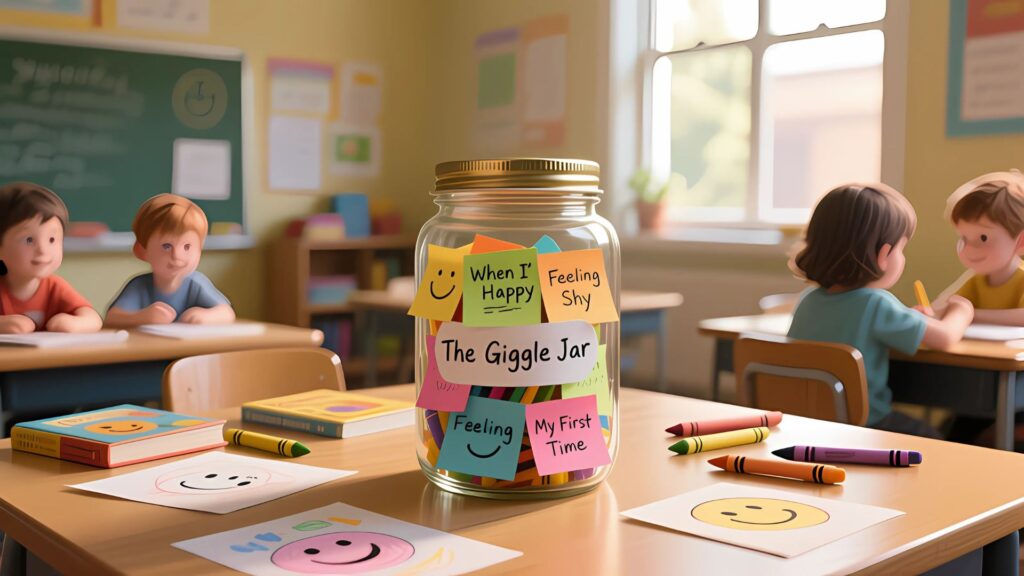
Sammy loved to laugh.
He laughed at jokes.
He laughed at silly faces.
He even laughed when nothing was funny at all.
At the breakfast table, his spoon slipped into the milk.
The splash was tiny.
But Sammy laughed so hard he almost tipped over.
His sister rolled her eyes.
“Sammy, you laugh at everything.”
Sammy giggled again.
At school, Sammy’s laugh bounced around the classroom.
It was loud.
It was bubbly.
It made some kids laugh with him.
But sometimes, it made others frown.
One morning, his friend Max tripped and fell.
Sammy laughed without thinking.
The sound burst out of him like popcorn.
But Max didn’t laugh.
He looked down.
His cheeks turned red.
“It’s not funny, Sammy,” he said.
Sammy’s smile dropped.
That afternoon, Sammy couldn’t stop thinking about it.
Why did his laugh make Max upset?
He didn’t mean to hurt him.
He just… couldn’t hold it in.
The laughter was like a bubble that had to pop.
The next day, his teacher, Ms. Green, noticed.
“Sammy, you seem quiet today,” she said.
Sammy shrugged.
“I think my laugh makes people mad.”
Ms. Green tilted her head.
“Your laugh is wonderful,” she said.
“But sometimes, we have to save it for the right moment.”
Sammy frowned.
“Save it? How?”
Ms. Green smiled.
“Imagine a special jar. A giggle jar. Every time you feel like laughing at the wrong time, you put your giggle inside the jar. Then, later, you can open the jar and let it out.”
Sammy blinked.
“A real jar?”
She chuckled.
“Not real. A pretend jar in your mind.”
That night, Sammy told his mom about the giggle jar.
She grinned.
“I love that idea.”
She handed him an empty cookie jar.
“Here. Use this to help you remember.”
Sammy placed it on his nightstand.
It was clear and round, with a shiny lid.
He imagined his giggles floating inside.
The next day, Sammy tried it out.
During reading time, his classmate sneezed so loudly the papers flew off his desk.
Sammy’s belly shook with laughter.
He wanted to burst.
But he whispered to himself, “Into the giggle jar.”
He imagined scooping the laugh and tucking it away.
He smiled quietly instead.
At recess, he opened the jar in his mind.
He let the laugh fly out.
It was huge.
It was free.
He rolled in the grass, giggling until his stomach hurt.
His friends joined in.
And this time, nobody felt bad.
The giggle jar became Sammy’s secret power.
He saved his laughter when someone was hurt.
He saved it when the teacher was serious.
He saved it when his sister was upset.
And later, when the time was right, he opened the jar wide.
The giggles poured out like sunshine.
One day, his friend Max stubbed his toe.
Sammy felt the giggle bubbling.
But he caught it.
He tucked it into the jar.
Instead, he asked, “Are you okay?”
Max nodded, surprised.
“Thanks, Sammy.”
Later, at recess, Sammy opened the jar.
The laughter exploded.
And this time, Max laughed with him.
Sammy noticed something new.
His laugh felt even better when it didn’t hurt anyone.
It was like sharing a cookie instead of eating it alone.
Sweeter.
At home, Sammy’s sister dropped spaghetti on the floor.
Sauce splattered everywhere.
Sammy pressed his lips together.
He stuffed the laugh into the jar.
He ran to get paper towels.
His sister blinked.
“You didn’t laugh?”
Sammy grinned.
“Not yet.”
Later, in his room, he opened the jar.
And laughed until his pillow bounced.
Sammy started teaching his friends about the giggle jar.
They tried it too.
Some pretended to lock their jars with golden keys.
Others painted theirs with sparkles in their minds.
Together, they saved their giggles for later.
Playtime became even more fun.
But sometimes, Sammy forgot.
One morning, he laughed when the teacher dropped her chalk.
The giggle slipped out too fast.
Ms. Green raised an eyebrow.
Sammy blushed.
“Oops. Forgot the jar.”
She smiled kindly.
“That’s okay. You can always try again.”
Sammy realized the jar wasn’t about being perfect.
It was about trying.
And every time he tried, he got better at it.
One rainy day, the class had to stay inside.
Everyone was grumpy.
Sammy felt the jar inside him fill up.
It was heavy with giggles.
So he asked, “Can we open our jars together?”
Ms. Green laughed.
“Why not?”
The whole class let out their giggles.
The room filled with joy.
Even the rain outside seemed to laugh with them.
Sammy never stopped loving his laugh.
It was still loud.
It was still bubbly.
But now, it was also kind.
And he learned that laughter, when shared at the right time, was a gift.
Lesson of the Story
Laughter is wonderful.
It makes hearts lighter.
It makes days brighter.
But sometimes, laughter can hurt if it comes at the wrong time.
The giggle jar reminds us we can hold onto joy until it’s ready to be shared.
And when it is shared, it shines even brighter.
4. Ellie and the Worry Monster
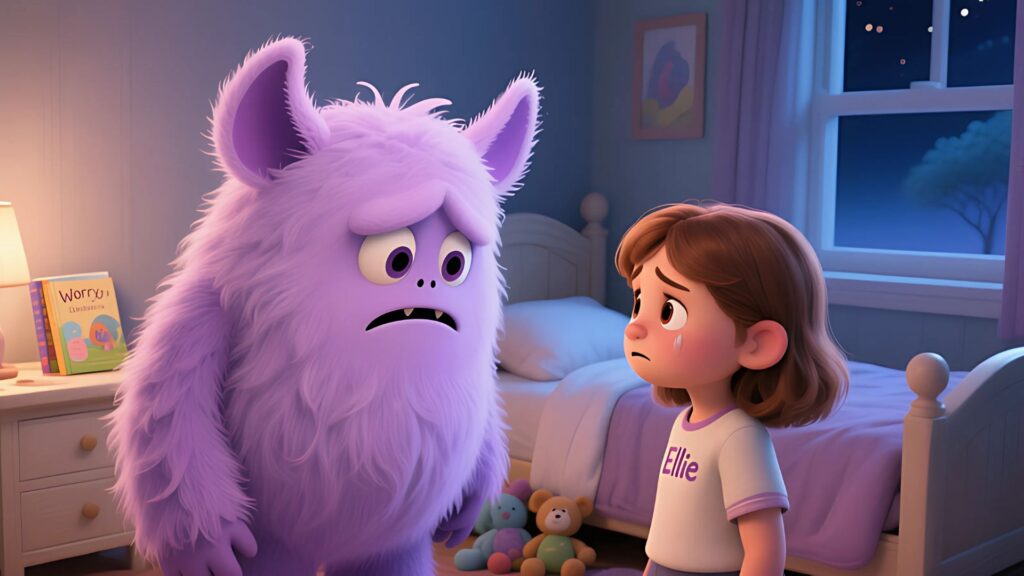
Ellie worried.
She worried about little things.
She worried about big things.
Sometimes, she even worried about worrying.
In the morning, she worried about being late.
At school, she worried about getting the answer wrong.
At night, she worried about monsters under the bed.
But the scariest monster wasn’t under her bed.
It was on her shoulder.
The worry monster was small at first.
It whispered in her ear.
“What if you forget your homework?”
“What if nobody wants to play with you?”
“What if you trip in front of everyone?”
The whispers made Ellie’s heart pound.
Soon, the monster grew.
It had big eyes that never blinked.
It had sharp little teeth.
And it followed her everywhere.
On the bus.
In class.
Even at the dinner table.
Ellie tried to ignore it.
But the monster tugged at her sleeve.
It pulled her hair.
It poked her ear.
“Don’t forget about me,” it hissed.
Ellie sighed.
She wished it would go away.
One day, her teacher noticed.
“Ellie, you seem quiet,” she said.
Ellie looked down.
She wanted to tell her about the monster.
But the monster growled.
“Don’t tell anyone. They’ll laugh.”
So Ellie stayed silent.
That night, Ellie lay in bed.
The monster was heavier than ever.
She couldn’t sleep.
She tossed and turned.
Finally, she sat up.
She grabbed her notebook.
And she drew the monster.
She gave it round glasses.
She gave it a silly bow tie.
She drew its teeth crooked.
She even gave it a goofy name: Mr. Flibber.
When she looked at the picture, she giggled.
For the first time, the monster didn’t seem so scary.
The next morning, Ellie showed her mom.
“This is my worry monster,” she said.
Her mom studied the picture.
“Well,” she said, “he looks more silly than scary.”
Ellie smiled.
“That’s the point.”
At school, the monster still whispered.
“What if you mess up reading aloud?”
Ellie held the drawing in her pocket.
She peeked at it.
Mr. Flibber grinned back with his crooked teeth.
Ellie whispered, “You’re not the boss of me.”
The monster shrank.
Just a little.
When she got nervous before gym, the monster grew again.
“What if you miss the ball? Everyone will laugh.”
Ellie pulled out her drawing.
She stuck out her tongue at it.
“Flibber, you’re silly.”
She swung the bat anyway.
And guess what?
She hit the ball.
The monster didn’t vanish completely.
It still followed her.
But every time she named it, every time she laughed at it, it shrank.
The whispers grew softer.
The teeth looked less sharp.
And Ellie felt braver.
One day, her best friend Nora looked worried too.
Her hands twisted together.
Her eyes darted around.
Ellie asked, “What’s wrong?”
Nora whispered, “I’m scared of the spelling test.”
Ellie thought about Mr. Flibber.
She pulled out the drawing.
“This is my worry monster. Do you have one too?”
Nora blinked.
“You… drew yours?”
Ellie nodded.
“Yep. I named him. It makes him smaller.”
Nora smiled a little.
“Maybe I’ll try that.”
She grabbed a pencil and drew a lumpy blob with floppy ears.
“I’ll call mine Mr. Snorf.”
They both laughed.
Soon, other kids joined in.
Some drew tall, thin monsters.
Some drew tiny, fuzzy ones.
Some gave them names like Grumble, Stinky, or Bubble-Nose.
The classroom filled with drawings.
And something amazing happened.
The monsters didn’t seem so scary anymore.
At bedtime, Ellie still worried sometimes.
But now, she pulled out her drawing.
She whispered, “Goodnight, Mr. Flibber. You’re not the boss of me.”
And the monster curled up small, like a harmless pet.
Ellie drifted off to sleep.
Weeks passed.
Ellie got better at spotting the monster early.
She noticed the whispers before they got too loud.
She noticed the tight feeling in her chest.
And she reached for her tools: her drawing, her words, her laugh.
The monster couldn’t trick her as easily anymore.
One day, Ellie stood in front of the class to give a report.
Her hands shook.
Mr. Flibber whispered, “You’ll forget everything.”
Ellie took a deep breath.
She looked at her drawing taped inside her notebook.
She smiled.
“Not today, Flibber.”
And she began to read.
Her voice was steady.
The class clapped when she finished.
The monster?
Nowhere in sight.
Ellie still had worries sometimes.
Everyone does.
But now, she knew a secret.
Worries are just monsters in disguise.
If you give them silly names, if you laugh at them, they shrink.
They lose their power.
And you grow stronger.
Lesson of the Story
Worries can feel like monsters.
They whisper in our ears.
They try to scare us.
But when we draw them, name them, and laugh at them, they get smaller.
And we get braver.
Because worries aren’t the boss of us.
5. Ben and the Shaky Hands
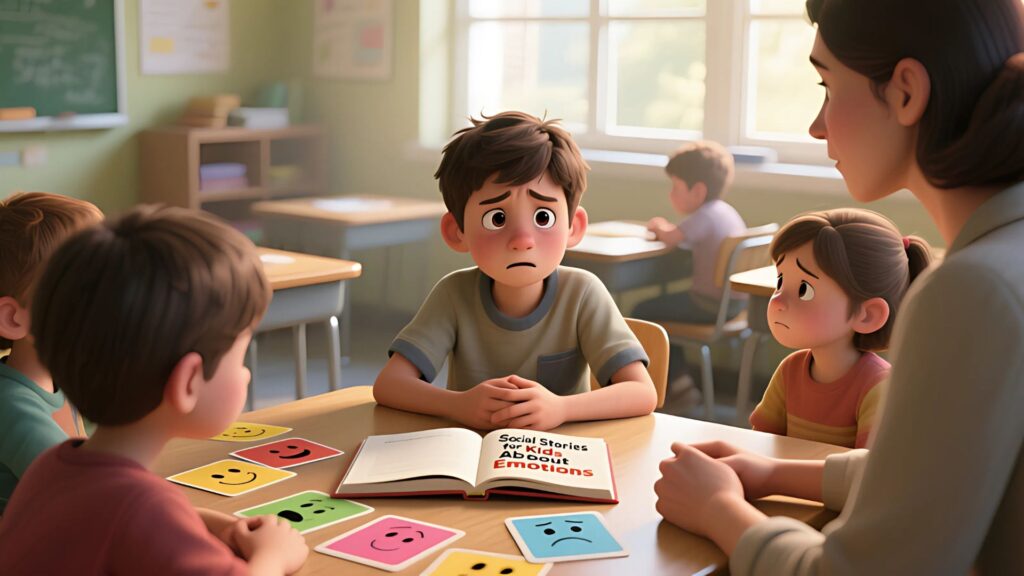
Ben’s hands shook.
They shook when he held a pencil.
They shook when he picked up his juice box.
But they shook the most when he had to speak in class.
When the teacher called his name, his stomach dropped.
His palms got sweaty.
His fingers trembled like tiny leaves in the wind.
He wished he could disappear.
One morning, Ms. Lopez said, “Ben, would you like to read the next sentence?”
Ben froze.
The book felt heavy in his hands.
His voice wobbled.
His hands shook so much that the pages rattled.
Some kids whispered.
Ben’s ears burned.
He wanted to sink under his desk.
At lunch, Ben poked his sandwich.
He didn’t feel hungry.
His friend Mateo asked, “Why didn’t you read?”
Ben muttered, “My hands shake. Everyone saw.”
Mateo tilted his head.
“So what? My legs shake when I run too fast.”
Ben frowned.
“It’s not the same.”
That night, Ben told his mom.
“My hands won’t stop shaking.”
His mom squeezed his hand gently.
“Do you know who else shakes before doing something big?”
“Who?”
“Superheroes,” she said.
Ben blinked.
“Superheroes?”
She nodded.
“They get nervous before flying or saving the day. It means their bodies are ready.”
Ben thought about that in bed.
Superheroes got shaky too?
Maybe shaking wasn’t weakness.
Maybe it was power waiting to be used.
The next day, Ms. Lopez asked for volunteers.
Ben’s heart pounded.
The monster in his head whispered, “Don’t do it. You’ll mess up.”
But another voice whispered too—his mom’s.
“Even superheroes get nervous.”
Ben raised his hand.
The class went quiet.
Ms. Lopez smiled.
“Go ahead, Ben.”
His hands trembled as he lifted the book.
His breath caught in his chest.
But he remembered—shaking meant power.
He read slowly.
His voice cracked.
But the words came out.
One by one.
When he finished, the class clapped.
Ms. Lopez said, “Well done, Ben.”
Ben’s cheeks turned pink.
His hands still shook.
But now they shook with pride.
Later, at recess, Ben tried again.
He stood on the steps and told a funny story.
His hands waved in the air.
They wobbled, but they also danced.
His friends laughed—not at him, but with him.
Ben grinned.
The shaking didn’t stop him.
It helped him move.
At home, Ben practiced in the mirror.
He pretended he was giving a speech.
He held a toy microphone.
His hands shook like usual.
But he told himself, “This is my superpower.”
And little by little, the shaking felt less scary.
One Friday, the class had to present projects.
Ben’s stomach twisted.
His poster felt too big.
His hands shook so hard the paper crinkled.
He wanted to run.
But he remembered superheroes.
He whispered to himself, “Power, not weakness.”
And he stepped up.
He began to talk about planets.
At first, his voice wavered.
But the more he spoke, the stronger it grew.
His hands still shook, but he used them to point.
He circled Jupiter.
He traced Saturn’s rings.
The class leaned in.
Nobody laughed.
When he finished, they clapped again.
This time louder.
Ms. Lopez said, “See, Ben? Nerves mean you care. And caring makes you shine.”
Ben smiled.
Maybe his shaking hands weren’t a problem.
Maybe they were part of who he was.
That evening, Ben told his mom about the project.
“I was nervous,” he said.
“But I did it anyway.”
His mom hugged him tight.
“That’s the bravest kind of courage,” she said.
“Doing it even when you’re scared.”
The next week, his friend Maya whispered, “My legs shake before soccer games.”
Ben nodded.
“That means you’re strong. Even superheroes shake.”
Maya smiled.
“Really?”
“Really,” Ben said.
From then on, Ben didn’t hide his shaky hands.
He lifted them proudly when he spoke.
He let them move when he read.
They became part of his courage.
Not something to be ashamed of.
Sometimes, his hands still shook a lot.
Before tests.
Before new places.
Before standing in front of strangers.
But instead of wishing the shaking away, Ben whispered, “Hello, superpower.”
And he carried on.
Because shaking wasn’t weakness anymore.
It was proof he was brave enough to try.
And every time he tried, his courage grew.
Lesson of the Story
Nervousness shows up in different ways—shaky hands, wobbly knees, fast hearts.
It doesn’t mean weakness.
It means you care.
It means your body is ready.
And like Ben, you can turn nerves into courage.
Because even superheroes shake before flying.
6. Lila’s Bubble of Calm
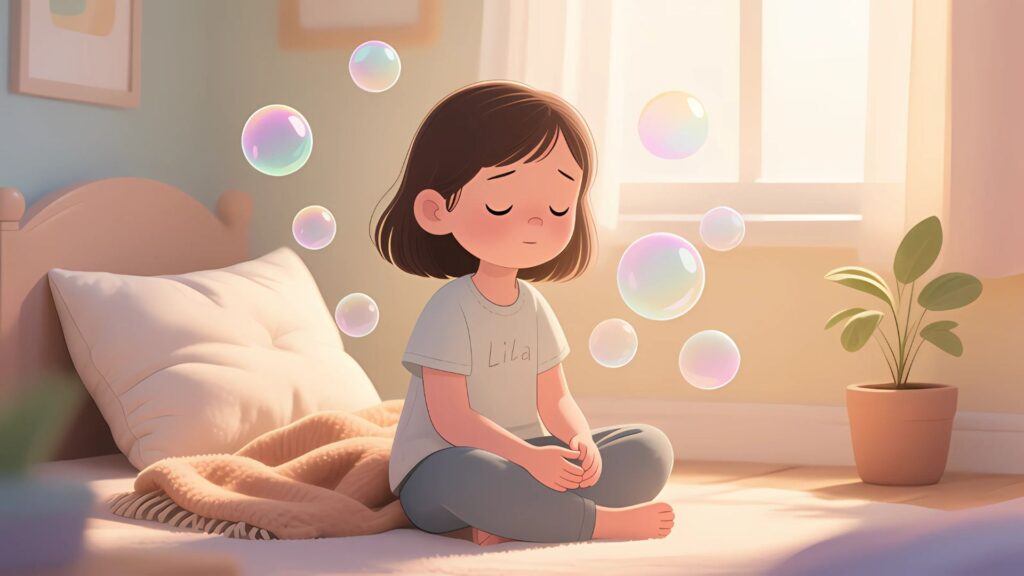
Ben’s hands always shook.
Not all the time.
Not when he was drawing or building with his blocks.
But whenever he had to stand up in front of people—his hands trembled like leaves in the wind.
At first, he thought no one noticed.
But one morning, when the teacher asked the class to read their poems out loud, Ben felt the shakes coming again.
He held the paper tight.
The words blurred because the page wobbled.
His voice trembled, too.
A boy in the back whispered, “Look, his hands are dancing.”
A few kids giggled.
Ben’s cheeks burned.
He rushed through the poem as fast as he could, sat down, and shoved the paper into his desk.
For the rest of the day, he kept his hands hidden under the table.
That night at dinner, Mom asked, “How was school?”
Ben poked at his mashed potatoes.
“Fine,” he said.
But his hands shook again just thinking about it.
Dad noticed.
He reached over and held Ben’s hand gently.
“You okay, champ?”
Ben shrugged.
“They always shake,” he whispered.
“Especially when I talk in front of everyone.”
Mom smiled softly.
“You know,” she said, “even grown-ups get shaky. I still feel nervous when I have to speak at meetings.”
Ben looked up.
“You do?”
“Of course,” she said. “My voice shakes, too. But I breathe, and it gets easier.”
Ben didn’t feel like it got easier.
Not at all.
The next week, the teacher announced, “We’re going to start sharing stories every Friday. Everyone will have a chance.”
Ben’s stomach dropped.
His hands tingled just hearing it.
All week, he worried.
At recess, he couldn’t enjoy soccer.
At bedtime, he tossed and turned.
By Thursday night, his heart beat like a drum.
What if his hands shook so much the paper ripped?
What if everyone laughed again?
He almost wished he could be invisible.
Friday came too quickly.
Ben sat in class, knees bouncing.
One by one, kids shared their stories.
Maya read about her dog.
Leo told a funny adventure about pirates.
Everyone clapped.
Ben’s turn was last.
His name sounded loud when the teacher called it.
He froze.
His legs felt like stone.
But slowly, he stood.
He walked to the front, gripping the paper tight.
The letters wiggled as if the page were alive.
He wanted to run back to his seat.
Then he remembered what Dad said: even superheroes get nervous before flying.
He took a deep breath.
He looked at the first line.
And began to read.
At first, his voice shook.
His hands wobbled.
But he kept going.
Each word was like a step forward.
By the middle, the shaking slowed.
By the end, he even looked up once.
The class clapped.
Not loudly.
Not mockingly.
Just kind claps, like raindrops on the window.
Ben blinked.
Maybe… maybe it wasn’t so bad.
After class, his teacher knelt beside him.
“Ben, you did something brave,” she said.
He frowned.
“But my hands shook the whole time.”
“That’s not what I saw,” she said. “I saw a student who was scared and did it anyway. That’s real courage.”
Her words warmed him.
But he still wished his hands would stop.
That night, Ben stood in front of the bathroom mirror.
He held a book.
His hands shook.
But he whispered, “Even superheroes get nervous before flying.”
Then he read to his reflection.
The words sounded steadier.
He read again.
And again.
Mom peeked in.
“You practicing?” she asked.
Ben nodded.
“Your grandpa’s hands shook sometimes, too,” she said gently.
“They did?”
“Yes. But he never let that stop him. He still painted, built birdhouses, and even gave speeches at church.”
Ben’s eyes widened.
“Really?”
Mom kissed his head.
“Really. Shaky hands don’t mean weak hands.”
Over the next weeks, Ben practiced.
Every night, he stood in front of the mirror.
He read comics, poems, even cereal boxes out loud.
Sometimes his voice wobbled.
Sometimes it didn’t.
But each time, he finished.
At school, he started small.
When the teacher asked questions, he raised his hand once.
His voice cracked, but the answer was right.
The teacher smiled.
“Great job, Ben.”
His chest felt light.
One day at recess, a younger boy named Max tripped and spilled his lunch.
The other kids laughed.
Ben felt his own stomach twist.
He remembered what it felt like to be laughed at.
So he knelt down and helped Max pick up his food.
Max whispered, “Thanks. My hands shake sometimes when I write.”
Ben’s eyes widened.
“Mine, too,” he said.
They grinned at each other.
Suddenly, Ben didn’t feel so alone.
By spring, Ben still had shaky hands.
They trembled before spelling bees.
They wobbled during group projects.
But something had changed.
He no longer hid them.
When classmates asked, he said, “Yeah, they shake when I’m nervous. It’s just how my body works.”
And most of the time, kids nodded and moved on.
The last day of school came with a big assembly.
The teacher chose three students to read poems on stage.
Ben’s name was called.
For a second, he froze.
But then he thought: I’ve done this before. I can do it again.
He walked up.
The lights were bright.
His hands shook, yes.
But his voice carried clear and strong.
When he finished, the applause filled the room.
This time, it sounded like thunder—but the good kind, the kind that rolls after rain and makes the world feel fresh.
Ben smiled.
For the first time, the shakes didn’t matter.
Because he had learned something important.
Being brave didn’t mean not shaking.
It meant standing tall, even when you did.
7. Omar and the Share Chair
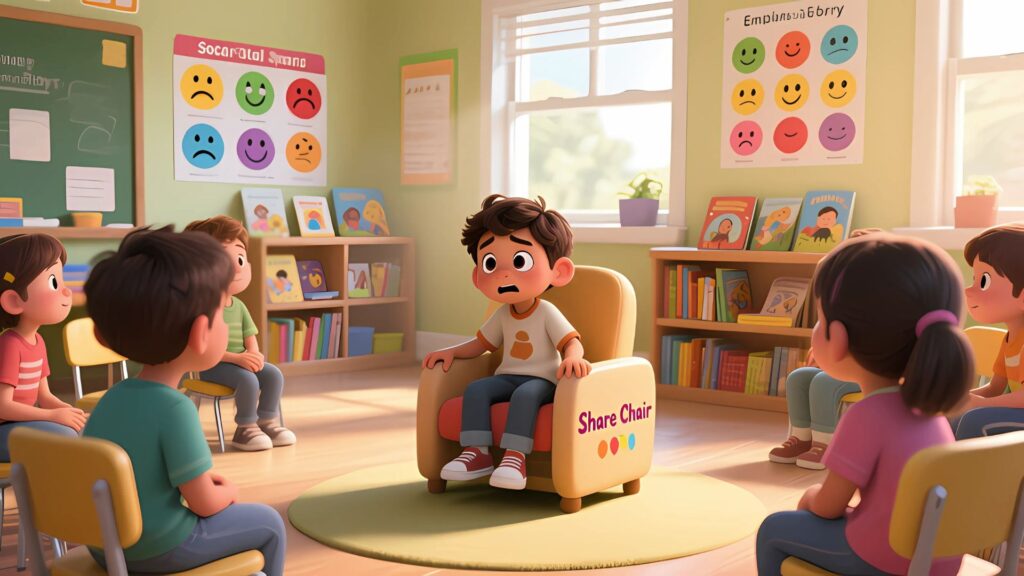
Omar loved his toys.
He loved his red fire truck, his green race car, and especially his big yellow dump truck.
But there was one thing he didn’t love.
Sharing.
Whenever someone asked, “Can I try?” Omar’s chest felt tight.
His arms wrapped around his toy like a shield.
And he shook his head hard.
“No. Mine.”
At home, his little sister Layla often wanted to play.
“Just one turn,” she begged.
But Omar hugged the dump truck to his chest.
Layla’s face scrunched.
She stomped away.
Sometimes she even cried.
Omar felt bad, but the bad feeling was smaller than the thought of losing his truck.
So he kept it close.
Always.
One Monday at school, the teacher brought out a shiny new toy set.
It was a box of colorful building blocks.
The kids gasped.
Everyone wanted a turn.
But when the box reached Omar, he grabbed a big handful.
He built a tower so tall, it wobbled.
“Can I use the blue one?” Maya asked.
Omar shook his head.
“No.”
Soon, kids stopped asking.
They sat nearby, building tiny houses with the scraps left.
Omar’s tower rose higher, but no one was watching.
At cleanup time, the teacher, Miss Rosa, called him over.
“Omar, can I talk with you?”
Omar looked down.
His hands fidgeted.
He thought he was in trouble.
But Miss Rosa’s voice was gentle.
“I see how much you love your toys,” she said.
“That’s not bad. But I also notice it feels hard for you to share.”
Omar’s cheeks warmed.
He nodded.
“I don’t like it,” he whispered.
Miss Rosa smiled kindly.
“You know, lots of kids feel that way. That’s why we’re going to try something new.”
The next day, Miss Rosa rolled a small wooden chair into the circle.
It had a red cushion.
The kids leaned in.
“What’s that?” Maya asked.
“This,” Miss Rosa said, “is the Share Chair.”
She patted the cushion.
“If you sit here, you can talk about what makes sharing hard. And your friends will listen. No laughing. No teasing. Just listening.”
The kids blinked.
It sounded… different.
Then she looked at Omar.
“Omar, would you like to try first?”
Omar’s stomach flipped.
All eyes turned to him.
But something about the soft red cushion looked safe.
He nodded slowly.
He climbed onto the Share Chair.
It felt warm and soft.
His hands gripped the edges.
His voice was tiny.
“I don’t like sharing,” he said.
Silence filled the room.
Miss Rosa nodded.
“Can you tell us why?”
Omar’s eyes stung.
What if they laughed?
But no one did.
He swallowed hard.
“I’m scared my toy will break. Or get lost. And then I won’t have it anymore.”
The words tumbled out.
The class was quiet.
Then Maya raised her hand.
“I felt that way about my crayons,” she said.
“Once, someone used my purple and broke it. I cried.”
Ben nodded.
“My cousin lost my robot. I didn’t want to share for weeks.”
One by one, kids spoke.
Every story sounded like Omar’s.
For the first time, he didn’t feel alone.
When the circle was done, Miss Rosa said, “Thank you, Omar. You were brave to tell us.”
Omar’s chest felt lighter.
Not big and tight like before.
He walked back to his spot.
Maya gave him a small smile.
So did Ben.
It was like his words had built a bridge instead of a wall.
The next day at recess, Maya ran up.
“I brought my jump rope,” she said.
“You can try, if you want.”
Omar blinked.
She was offering first.
He hesitated.
But the rope glittered in the sun.
“Okay,” he said.
He held the handles.
His feet tripped, and he fell laughing.
Maya laughed too.
But it wasn’t mean laughter.
It was the kind that made his stomach feel warm.
When she took the rope back, she asked, “Want to share your dump truck next time?”
Omar thought about it.
His chest tightened… but not as much.
“Maybe,” he whispered.
At home, Omar told Layla about the Share Chair.
She clapped her hands.
“Can I try it?” she asked.
Omar set up a little stool with a pillow.
Layla climbed on.
“I don’t like when you don’t share,” she said seriously.
Omar giggled.
“Okay, okay.”
Then he handed her the dump truck.
Layla’s eyes went wide.
“You mean it?”
“Just for five minutes,” Omar said.
But inside, his chest didn’t feel so tight.
It felt… proud.
Weeks passed.
The Share Chair became a favorite spot in class.
Sometimes kids talked about toys.
Sometimes about feelings.
Even Miss Rosa sat there once.
She told them she used to hate sharing her books as a child.
Everyone laughed gently, even her.
Sharing, they learned, wasn’t just about toys.
It was about sharing fears, words, and even mistakes.
One Friday, Miss Rosa brought out a special box.
Inside was a brand-new set of blocks—shiny, colorful, and tall.
“Today,” she said, “we’ll build together.”
Omar’s heart raced.
The blocks reminded him of the tower he’d hogged weeks ago.
But when Maya reached for a red one, he paused.
His chest felt tight.
Then he took a deep breath.
“Here,” he said, handing it over.
Maya’s smile lit up the room.
“Thanks, Omar.”
Ben added, “You’re good at building towers. Want to help with mine?”
Omar’s chest loosened.
He grinned.
“Okay.”
And together, they built the tallest tower yet.
It didn’t wobble this time.
It stood strong—just like Omar.
By the end of the year, Omar was still learning.
Sharing wasn’t always easy.
Sometimes his chest tightened.
Sometimes his arms wanted to wrap around his toys.
But he remembered the Share Chair.
He remembered Maya’s jump rope.
He remembered Layla’s smile when he gave her the dump truck.
And he remembered how light it felt when he shared.
On the last day of school, Miss Rosa asked everyone to share one thing they were proud of.
Omar raised his hand.
He stood up tall.
“I’m proud that I learned to share,” he said.
The class clapped.
And this time, the clapping felt like sunshine on his shoulders.
8. Nina and the Jealous Shadow
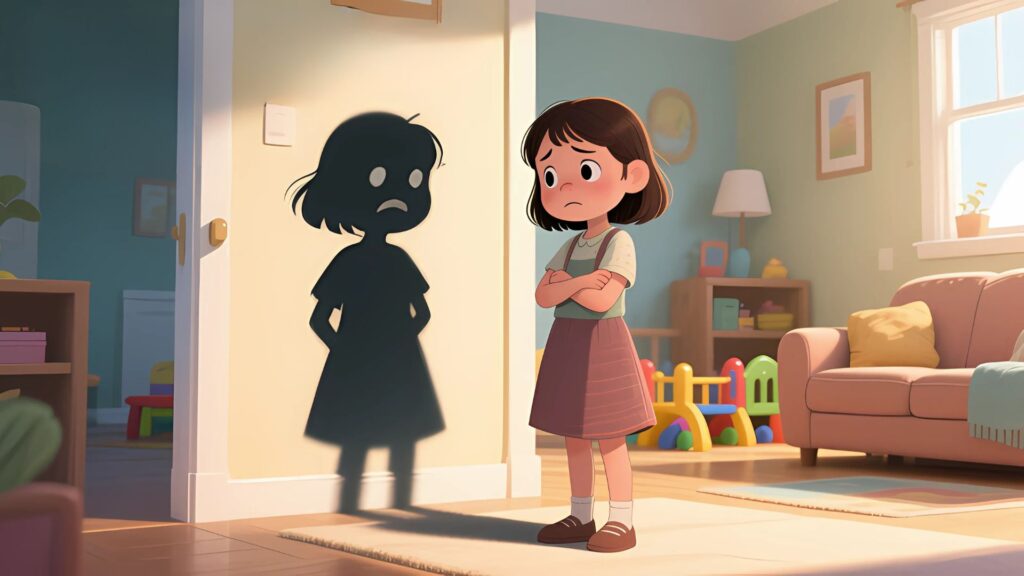
Nina loved her best friend, Sara.
They played together every day.
They built towers, drew pictures, and even shared snacks.
But one day, something changed.
Sara played with someone else.
Nina felt a weird weight in her chest.
A shadow appeared behind her.
It wasn’t a dark shadow, exactly.
It was heavy and cold.
It followed her everywhere.
When she smiled at Sara, the shadow stretched.
When she waved, it pulled her hand down.
Nina didn’t know what to do.
At school, Sara laughed with another girl, Mia.
Nina’s shadow grew taller.
It curled around her like a blanket made of rocks.
Her heart thumped.
Her legs felt like jelly.
Her shadow whispered: “She doesn’t need you anymore. She likes her new friend more.”
Nina frowned.
She wanted the shadow to go away.
But it didn’t.
That night, Nina told her mom.
“I feel… heavy,” she said.
Mom tilted her head.
“Heavy?”
“Yes,” Nina whispered. “When Sara plays with Mia… my shadow follows me.”
Mom smiled softly.
“Ah, that’s jealousy, sweetheart. It’s normal to feel that way.”
Nina’s eyes widened.
“Normal?”
“Yes,” Mom said. “It’s okay to feel upset when someone you care about spends time with others.”
“But it hurts!” Nina said.
Mom nodded.
“I know. But there are ways to shrink your shadow.”
The next day, Nina tried to focus on her own activities.
She drew a picture.
She built a small tower of blocks.
The shadow shrank a little.
But when Sara laughed with Mia again, it grew.
Nina sighed.
Her shadow tugged at her feet.
It whispered again, “She likes her new friend more. You’ll be alone.”
Nina stomped her foot.
“Stop!” she yelled.
But the shadow didn’t listen.
During recess, Nina sat alone.
Sara waved.
Nina waved back, but the shadow hung heavy.
Her stomach twisted.
She wanted to join, but her shadow made her feet stick.
Then she remembered something Mom said.
“Talk to your shadow. Give it a name.”
Nina tilted her head.
“Give it a name?”
“Yes,” Mom said. “It helps you see it for what it is, and not let it control you.”
That afternoon, Nina grabbed her notebook.
She drew the shadow.
It was big, looming, and wriggly.
She gave it tiny wings.
She gave it googly eyes.
She named it “Shadoodle.”
When she looked at her drawing, she giggled.
For the first time, her shadow didn’t feel so heavy.
The next day at school, Shadoodle whispered less.
When Sara played with Mia, Nina’s chest felt tight for a moment.
Then she whispered to Shadoodle: “It’s okay. I can be happy for them.”
The shadow shrank.
It hovered like a small balloon, harmless and light.
Nina smiled.
She ran to swing on the playground.
Shadoodle followed, but only as a tiny shadow behind her feet.
During art class, Nina painted a rainbow.
She painted a blue sky with green hills.
Shadoodle peeked from the corner of the page.
It didn’t feel scary anymore.
It looked funny, like a little pet.
Nina whispered, “You don’t scare me, Shadoodle. You’re just… part of me.”
Shadoodle flapped its tiny wings.
It seemed to nod.
One day, Sara came to Nina.
“Do you want to play a new game?” she asked.
Nina’s chest tightened.
The shadow grew a little.
But she remembered Shadoodle.
She took a deep breath.
“Sure!” she said.
As they played, the shadow floated behind her.
It stayed small, like a balloon tied to her wrist.
Nina laughed.
The shadow giggled with her.
It wasn’t heavy anymore.
Weeks passed.
Sometimes, Nina felt jealousy.
Sometimes, Shadoodle stretched a little taller.
But she knew how to shrink it.
She named it.
She laughed at it.
She talked to it.
She reminded herself that her friendship wasn’t gone.
It had just changed a little.
At school, other kids noticed.
When someone got a new toy or a new friend, they felt jealous too.
Nina shared Shadoodle’s trick.
“Draw it,” she said.
“Give it a funny name. Make it small. Then it won’t control you.”
Kids tried it.
The classroom felt lighter.
Laughter floated higher.
Shadows were no longer heavy.
At home, Nina told Mom about sharing the trick with her friends.
Mom smiled.
“I’m proud of you,” she said.
“Learning to notice jealousy, name it, and shrink it… that’s a big step.”
Nina nodded.
She felt warm inside.
Shadoodle sat quietly on her desk.
It was small, and it flapped its tiny wings.
It didn’t scare her anymore.
One sunny afternoon, Nina walked home with Sara and Mia.
The three laughed and ran along the sidewalk.
Shadoodle hovered gently above her shoulder.
Nina looked at her shadow and smiled.
She whispered, “Thanks for helping me, but you can stay small now.”
Shadoodle winked.
And floated quietly behind her.
Nina realized something important.
Jealousy wasn’t bad.
It was just a feeling.
A shadow that sometimes grew too big.
But with kindness, laughter, and a little imagination, it could shrink.
She could be happy for friends.
And still be herself.
That night, Nina drew a picture of her friends.
Shadoodle perched in the corner, tiny and harmless.
Nina hugged her notebook.
She whispered, “I can handle you now.”
The shadow didn’t loom.
It didn’t whisper.
It just fluttered softly, like a small balloon in the sky.
And Nina slept soundly.
Lesson of the Story
Jealousy can feel like a shadow.
It follows us, grows heavy, and whispers scary thoughts.
But when we notice it, name it, and laugh at it, it shrinks.
And then we can enjoy friendships, even when they change a little.
Because feelings aren’t the boss of us.
9. Tommy’s Brave Step
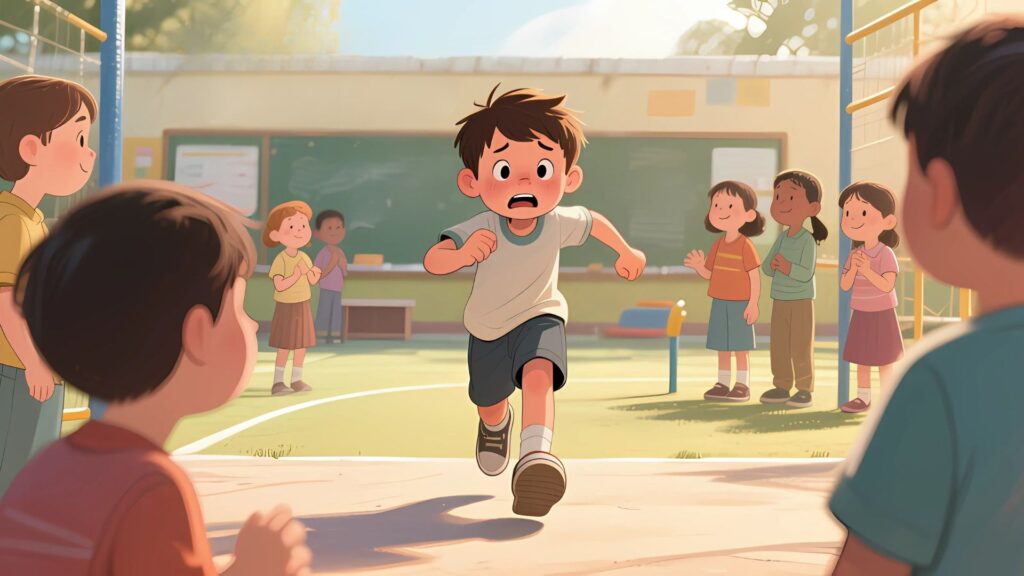
Tommy loved the playground.
He liked the swings, the slides, and the sandbox.
But there was one thing he didn’t like.
The big slide.
It was tall.
Taller than any slide he had ever seen.
Its bright red ladder gleamed in the sun.
The slide curved like a dragon’s tail.
Tommy’s stomach flipped just looking at it.
Every day, his friends played on it.
They climbed up, whooshed down, and laughed.
“Come on, Tommy!” shouted Leo.
“Don’t be scared!” Maya cheered.
Tommy watched.
He felt a mix of excitement and fear swirling in his chest.
Like butterflies fighting a storm.
He tried small slides.
Short ones, gentle curves.
He went down with a smile.
But the big slide… it loomed.
It whispered: “You can’t do this.”
He wanted to prove himself.
He wanted to join his friends.
But his legs shook.
His heart thumped like a drum.
One morning, Tommy’s dad came to the playground.
“Ready to try the big one today?” he asked.
Tommy shook his head.
“I don’t think so.”
Dad crouched beside him.
“Sometimes, being brave doesn’t mean not being scared.
It means trying even when you are scared.”
Tommy frowned.
His hands fidgeted with his shoelaces.
“I don’t know if I can.”
Dad smiled.
“I know you can. One small step at a time.”
Tommy thought about that all day.
The sun was warm.
The grass smelled fresh.
The big slide called to him, whispering: Are you ready?
He imagined himself sliding down.
His stomach felt tight, but something in him stirred.
The next day, Tommy climbed the ladder.
One step.
Then another.
His friends cheered quietly.
“Go, Tommy!” whispered Leo.
Tommy reached the top.
He looked down.
The ground seemed far away.
His heart raced.
Shaky hands gripped the rails.
He wanted to turn back.
But he remembered Dad’s words.
“One small step at a time.”
He took a deep breath.
He imagined himself like a superhero.
A superhero who trembled before flying but still soared.
And then… he took a step.
Down he went.
The wind rushed past.
The slide twisted and turned.
His stomach flipped, and a scream escaped his mouth.
It wasn’t scary—it was exciting.
And then he hit the bottom.
Feet on the ground.
He landed safely.
Tommy laughed.
It was loud and joyful.
His friends clapped and ran over.
“You did it!” shouted Leo.
“See? You’re brave!” said Maya.
Tommy’s cheeks burned.
Not with shame, but with pride.
He did it.
He really did it.
The next day, he tried again.
This time, he didn’t look down.
He didn’t think about being scared.
He just climbed, stepped, and slid.
His friends cheered louder.
The thrill made him giggle.
And each time, the fear got smaller.
One afternoon, a new student named Lily watched from the swing set.
“I’m too scared,” she whispered.
Tommy thought about the big slide.
He remembered the butterflies, the fear, and the joy at the bottom.
He walked over.
“Do you want to try?” he asked.
Lily shook her head.
Tommy smiled.
“I was scared too. But I took one small step. Then another.
You can do it, and I’ll be right here.”
Lily hesitated, then nodded.
They climbed the ladder together.
Step by step.
Tommy held her hand.
The slide loomed, but they didn’t look down.
Shaky hearts, but brave spirits.
Down they went.
Screaming and laughing.
Landing together at the bottom.
“Again!” Lily shouted.
Tommy grinned.
Over the next few weeks, Tommy became the playground hero.
Not because he was the fastest or the strongest.
But because he learned that courage isn’t about not being scared.
It’s about moving forward, even when your heart beats fast.
He helped friends.
He cheered them.
He shared his fear, and they shared theirs.
One rainy day, the playground was empty.
Tommy went alone.
He looked at the big slide.
His chest tightened.
Then he smiled.
He remembered all the small steps.
He remembered laughter.
He remembered helping Lily.
He climbed the ladder.
Step by step.
Slide after slide.
Until he reached the bottom and laughed like the wind.
By the end of the year, Tommy tried everything he once feared.
He climbed trees.
He crossed the rope bridge.
He even tried the new balance beam.
Shaky hands, racing heart, but brave steps.
His friends looked up to him.
Not because he was fearless, but because he tried.
Every single time.
At home, Tommy told his mom about the playground adventures.
“I was scared at first,” he said.
“But I did it anyway. And I helped Lily too.”
Mom hugged him tight.
“That’s real bravery,” she said.
“And it grows every time you take a step, even a small one.”
Tommy smiled.
He felt taller.
Stronger.
Ready for the next adventure.
The last day of school, the principal asked the kids to share something they were proud of.
Tommy raised his hand.
“I’m proud that I learned to be brave,” he said.
The class clapped.
Tommy’s chest felt warm.
His hands didn’t stop shaking sometimes.
But now, each shake reminded him:
He was alive.
He was trying.
He was brave.
And that was more than enough.
Lesson of the Story
Fear is normal.
Courage isn’t the absence of fear.
It’s about taking a step forward, even when your heart pounds and your hands shake.
One small step can lead to big adventures.
And helping friends along the way makes bravery grow even more.
10. Sofia’s Thank-You Tree
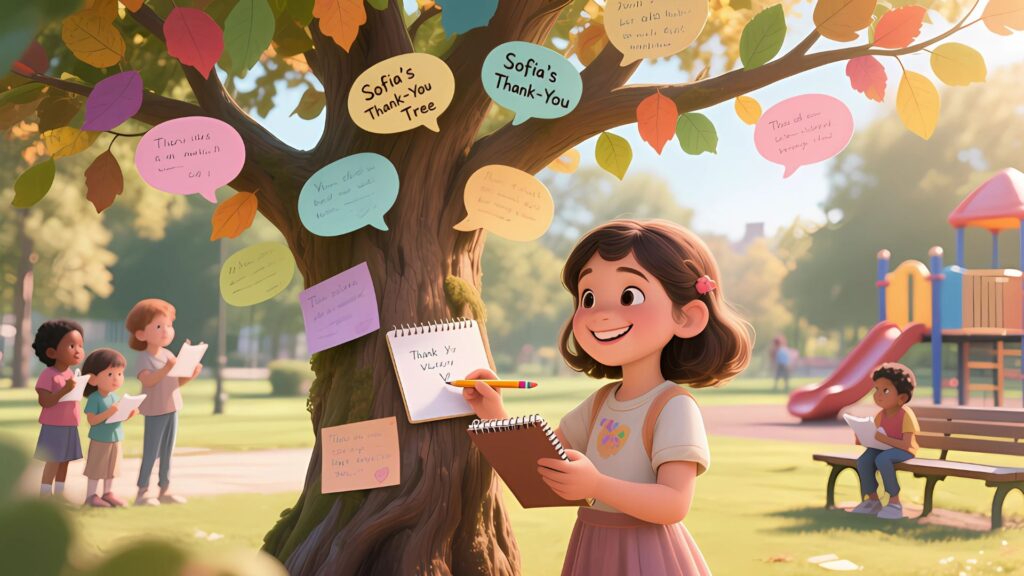
Sofia loved her toys, her books, and her little stuffed bunny, Momo.
But one afternoon, something happened that made her heart heavy.
Her little brother, Leo, accidentally broke her favorite toy car.
It was a bright red race car with shiny wheels.
Sofia’s eyes welled up with tears.
She wanted to yell.
She wanted to grab it back.
But she didn’t.
Her grandma noticed her sitting quietly.
“What’s wrong, Sofia?” she asked.
“My toy,” Sofia whispered.
Grandma smiled softly.
“Sometimes, things break. But there’s a way to feel better,” she said.
Sofia tilted her head.
“How?”
Grandma led her to the backyard.
There was a small tree.
It wasn’t tall, but its branches were strong.
“Look at this,” Grandma said.
“This is our Thank-You Tree.”
Sofia blinked.
“Thank-You Tree?”
“Yes,” Grandma said. “Whenever something makes you feel grateful—even small things—we write it down and hang it on the tree.”
Sofia’s eyes widened.
She liked the idea.
Grandma handed her paper and crayons.
“Write something you’re thankful for,” she said.
Sofia thought.
She picked up a green crayon.
She wrote: Thank you, Momo, for always being soft and warm.
She folded it into a leaf shape.
Grandma helped her hang it on the branch.
It fluttered lightly in the breeze.
Sofia smiled.
The next day, Sofia still felt upset about her broken car.
But she added another leaf to the tree.
Thank you, Leo, for trying to play carefully.
It felt funny to thank him when she was still mad.
But the leaf swayed, and a little warmth filled her chest.
She noticed her anger shrinking just a bit.
At school, Sofia told her friends about the Thank-You Tree.
They were curious.
“Can we do that too?” asked Maya.
“Sure,” Sofia said.
The idea spread.
Soon, everyone in the class was making leaves.
Some wrote: Thank you for my lunch.
Some wrote: Thank you for my teacher.
The leaves fluttered like colorful butterflies in the air.
Sofia discovered something surprising.
The more leaves she added, the lighter her heart felt.
Even when Leo knocked over her blocks, she found a way to write a thank-you leaf: Thank you for making me laugh.
Her grandma smiled at her one afternoon.
“You see,” she said, “gratitude doesn’t erase the problems. But it helps you carry them more easily.”
Sofia nodded.
It was true.
One windy day, Sofia had an idea.
“What if I make a leaf for something I feel upset about?”
Grandma nodded.
“Exactly. You can turn feelings into gratitude.”
Sofia picked a blue crayon.
She wrote: Thank you for my broken car, because it helps me be patient.
She hung it on the tree.
The wind tugged gently at the leaves.
It felt like the tree was smiling.
Her friends at school tried it too.
Even kids who were usually grumpy began to notice their feelings.
They wrote leaves for things like: Thank you for helping me clean up.
Thank you for my friend who shares.
The class became calmer, happier, and more patient.
Sofia felt proud.
She realized that gratitude could grow, just like leaves on a tree.
At home, Sofia kept adding leaves every day.
Some leaves were for big things: Thank you for my family.
Some were for small things: Thank you for the cookies Grandma baked.
Even her stuffed bunny Momo had a leaf.
The tree looked like a rainbow made of paper.
And every time she looked at it, her heart felt full.
One day, Leo came to her.
“I want to make a leaf too,” he said.
Sofia handed him paper and crayons.
He scribbled: Thank you, Sofia, for letting me play with you.
He hung it on the tree.
Sofia hugged him.
The shadow of anger she had felt earlier melted completely.
Weeks went by.
The Thank-You Tree grew taller, stronger, and more colorful.
Every leaf told a story.
Some leaves fluttered in the wind.
Some stayed still, like secrets kept safe.
Sofia loved reading them.
Sometimes, she laughed.
Sometimes, she felt a warm glow.
During a family picnic, Grandma said, “Why don’t we make a special leaf for each family member?”
Sofia and Leo picked crayons.
They wrote: Thank you, Grandma, for teaching me about gratitude.
Thank you, Mom, for cooking lunch.
Thank you, Dad, for playing with me.
The leaves swayed together, making the tree shimmer like sunlight.
Sofia realized something important.
Anger, sadness, and frustration didn’t disappear.
But when she focused on thankfulness, they felt smaller.
Her heart felt bigger, lighter, and stronger.
She could still feel upset sometimes.
But she also felt grateful, which helped her carry her feelings.
At school, the teacher noticed the change in Sofia.
“She’s more patient, kind, and thoughtful,” she said.
Sofia smiled.
She remembered writing the first leaf.
She remembered letting Leo add his leaf.
She remembered that little tree in the backyard that taught her something big.
One rainy afternoon, Sofia looked at the tree.
The wind shook the leaves.
Some leaves fell.
Some curled at the edges.
Grandma said, “Even when leaves fall, the tree is still strong. The leaves grow back.”
Sofia nodded.
It reminded her that gratitude, like leaves, grows and grows—even after hard days.
By the end of the year, Sofia had dozens of leaves.
Red, blue, green, yellow, orange.
Each leaf held a feeling, a memory, or a thank-you.
The tree looked magical.
And every time she saw it, she felt calm, strong, and happy.
On the last day of school, Sofia shared her story with her friends.
“Even if something breaks, or someone upsets you, or a day feels hard…” she said.
“You can still find something to be thankful for.”
The class clapped.
Her heart felt like sunshine.
Sofia smiled.
Her Thank-You Tree was alive—not just in the backyard, but in her heart too.
Lesson of the Story
Gratitude can turn small moments into joy.
It doesn’t erase problems.
But it helps your heart feel lighter, bigger, and stronger.
Even a broken toy or a hard day can become a chance to grow.
Writing down thank-yous, just like Sofia, can make every day brighter.
Why Kids Struggle So Much With Emotions
Here’s a stat that may surprise you: a study from Yale’s Center for Emotional Intelligence found that only one in three children can accurately name their feelings in the moment. Imagine how frustrating it must be to feel something so powerful without knowing what it is.
Adults often forget that children are still “learning the language of feelings.” For us, it’s easy to say, “I feel anxious about tomorrow’s meeting.” For kids, it comes out as kicking, crying, or refusing to talk.
Think of it like this: kids are carrying around a backpack of emotions, but the backpack doesn’t have labels. Everything — anger, sadness, fear, joy — is just tossed in together. Social stories are like little tags that say, “This is anger. This is sadness. Here’s what you can do with it.”
What Are Social Stories, Really?
At their core, social stories are short, clear, and relatable explanations of situations or emotions. They:
- Describe what’s happening.
- Show what someone might feel.
- Suggest safe, positive ways to respond.
They were first created for children with autism in the 1990s. But here’s the beautiful part: they’re now used with all kids, because every child needs help navigating big feelings.
Imagine social stories as emotional flashlights. They shine a little light on confusing situations, helping kids see what’s going on instead of stumbling in the dark.
Why Stories Beat Lectures
Here’s a quick test:
- Say to a child, “Don’t be scared. There’s nothing to worry about.”
- Then try, “Sometimes kids feel nervous before bedtime. It’s dark, and shadows can look spooky. But there are ways to feel safe, like cuddling a toy or turning on a night-light.”
Which one do you think lands better?
Stories work because they connect. They don’t shame or lecture. They say, “You’re not alone. Others feel this way too.” And according to child psychologist Paul Harris, children learn more deeply from imagined stories than from direct instruction. Stories let kids rehearse real life in a safe, gentle way.
It’s the difference between reading a recipe and tasting the food. The lesson sticks.
The “Big Seven” Emotions Kids Wrestle With
Let’s look at the most common emotions that send kids (and parents) spinning — and why social stories help with each one.
- Anger – Like a volcano bubbling inside, ready to erupt. Stories teach them that eruptions can be messy, but there are other ways to let steam out.
- Sadness – Like carrying a heavy backpack no one else can see. Stories remind them they’re allowed to take the backpack off for a while.
- Fear – Shadows on the wall can feel like monsters. Stories show that fear is normal, but also survivable.
- Excitement – Too much joy can feel like a shaken soda can. Stories teach kids to open slowly, not explode.
- Jealousy – Like watching someone else get a bigger slice of cake. Stories show that love and attention aren’t pie — there’s enough to go around.
- Pride – A warm balloon that can either lift you up or float too far. Stories help kids balance confidence with humility.
- Kindness/Empathy – The glue of relationships. Stories help kids see that everyone carries feelings, not just them.
A Simple Example: When Towers Fall
Picture this: your child spends 20 minutes building a tall tower of blocks. One wrong move and — crash! — it’s gone. Instantly, they’re in tears.
Here’s how a social story could look:
- “Sometimes towers fall down.”
- “When they fall, I feel sad or mad. My face feels hot. My hands want to throw things.”
- “It’s okay to feel sad or mad. Everyone feels that way sometimes.”
- “When I take a deep breath, my body feels calmer. Then I can build again.”
See how gentle that is? No shame, no scolding. Just a reminder that feelings are normal — and there’s a safe way forward.
How to Write Social Stories That Actually Work
Here’s the good news: you don’t need a degree in psychology to write them. You just need a little structure:
- Keep it short. Two or three sentences per page is plenty. Kids’ brains tune out lectures.
- Use kid-friendly “I” statements. Instead of, “Children often struggle with frustration,” write, “I feel mad when my toy breaks.”
- Show the positive. Don’t just say, “I don’t hit.” Say, “I use my words.”
- Add pictures. Even stick figures with speech bubbles work wonders.
- Read often. Stories aren’t one-time fixes. They’re practice — like brushing teeth for emotions.
Think of them as little emotional dress rehearsals.
Everyday Moments Where Stories Save the Day
Let’s get real: parenting and teaching are full of little emotional landmines. Here’s where social stories shine:
- First day of school – A story about butterflies in your stomach, making new friends, and finding your desk.
- Losing a game – A story about disappointment, cheering for friends, and trying again.
- Doctor visits – A story about the fear of shots, bravery, and lollipops afterward.
- Sharing toys – A story about the tug-of-war feeling inside, and how sharing leads to more fun.
- Bedtime – A story about scary shadows, cozy blankets, and finding peace in routine.
One teacher told me she keeps a basket of social stories in the classroom. When a child struggles, she simply says, “Want to read about another kid who felt this way?” Nine times out of ten, the child nods.
The Science Behind Naming Emotions
Here’s another stat worth knowing: according to the Gottman Institute, kids who learn to identify and talk about their feelings are more likely to succeed academically and socially.
Why? Because naming emotions reduces their power.
It’s like this: if emotions are wild animals, naming them is like putting a leash on them. They don’t disappear, but they become manageable.
When a child can say, “I feel jealous,” instead of just sulking or hitting, they’re already halfway to solving the problem.
The Role of Parents and Teachers
Here’s where we come in. Social stories don’t live on paper — they live in the moments we share them.
- Read together. A story isn’t homework. It’s connection time.
- Point back to it. When your child feels angry, say, “Remember the story about the tower?”
- Model it. Kids copy us more than they listen to us. If they see you breathe through frustration, they’ll try it too.
- Be patient. Emotions don’t untangle overnight. Think of social stories like planting seeds — growth happens quietly, over time.
Making Social Stories Part of Everyday Life
A few easy routines make all the difference:
- Bedtime rituals – Slip in a short social story before sleep.
- Morning check-ins – Ask, “What’s your feeling word today?” and connect it to a story.
- Calm-down corners – Keep a basket of printed stories where kids can grab them when upset.
- Classroom circles – Use them to talk about friendship, kindness, or frustration.
Think of them as emotional first-aid kits — always there when needed.
The Ripple Effect: Emotional Intelligence for Life
This isn’t just about fewer tantrums (though that’s nice too). It’s about building emotional intelligence — the ability to understand, manage, and express feelings in healthy ways.
And here’s the kicker: according to a study published in American Journal of Public Health, kids with strong social-emotional skills in kindergarten were more likely to graduate high school, get jobs, and stay out of trouble later in life.
So every little social story you tell isn’t just calming a meltdown. It’s shaping a child’s future.
Closing Thoughts: Small Stories, Big Impact
When kids are drowning in emotions, they don’t need lectures. They need lifelines. Social stories are those lifelines — small, simple, human reminders that feelings are normal, feelings are manageable, and they are never alone.
So the next time your child slams a door, bursts into tears, or refuses to budge, pause. Don’t jump straight to correction. Reach for a story.
Because sometimes the tiniest tale — just a few sentences long — is the thing that helps a child weather the storm, find their calm, and take the next brave step forward.

